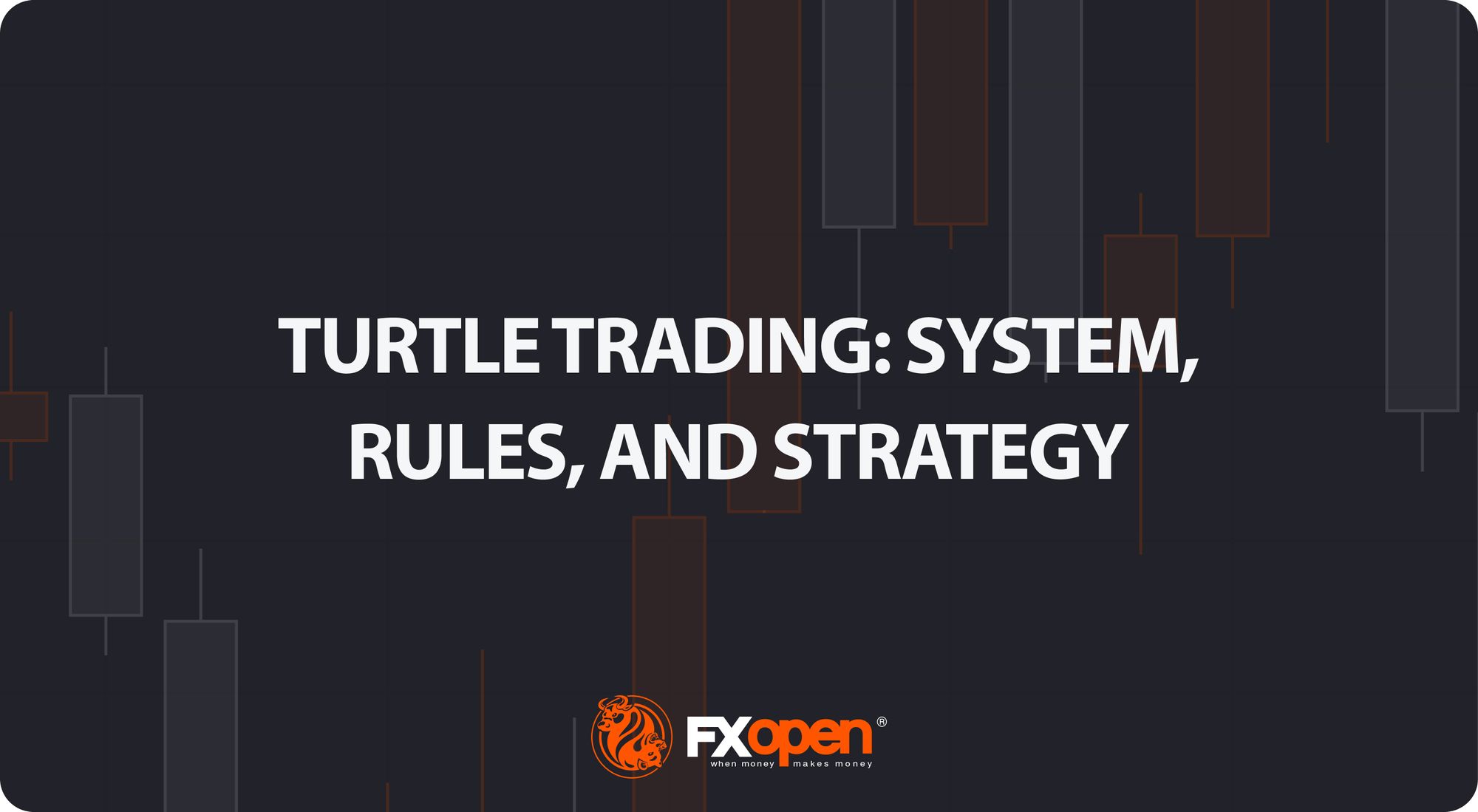FXOpen

In the 1980s, the Turtle Trading system was born from a debate about whether trading skills were innate or could be taught. Richard Dennis and William Eckhardt decided to train novices in their trend-following trading strategies, thus giving rise to the Turtle Trading system. This article explores the Turtle system, exploring its various facets and applications in a modern trading environment.
The Origins of Turtle Trading
The concept of Turtle Trading emerged from a unique experiment conducted in the early 1980s by two seasoned commodities traders, Richard Dennis and William Eckhardt. Disagreeing over whether trading could be taught or was an innate ability, they decided to settle their debate with a real-world test. Dennis believed that with the right instruction, anyone could learn to trade effectively, while Eckhardt held that trading success was attributable to genetic factors.
To test the hypothesis, Dennis placed an advertisement seeking trading apprentices in The Wall Street Journal. From over a thousand applicants, he selected 14 individuals for the original experiment—often referred to as the "Turtles." These participants, who came from diverse backgrounds, including a professional blackjack player and a fantasy game designer, were given a two-week intensive training in a simple trend-following system that traded a range of commodities, currencies, and bond markets.
The training focused on rules, discipline, and managing risk. The Turtles were taught to buy price breakouts and sell market breakdowns. Additionally, strict rules were set for position sizing and the use of stop-loss orders to manage potential losses. After the training, each Turtle received a trading account funded by Dennis, starting with amounts ranging from $500,000 to $2 million.
The results were extraordinary, leading some Turtles to earn returns in excess of 100% in a year. This outcome not only confirmed Dennis’s belief in the teachability of trading but also established the Turtle Trading System as a landmark in trading education.
Core Principles and Rules of Turtle Trading
The Turtle Trading system is anchored in the principle of trend following—specifically, capitalising on large, sustained price movements either upwards or downwards. This approach is rooted in the belief that financial markets move in trends more often than they behave erratically, and these trends can be identified and leveraged for substantial returns.
To achieve his results, Dennis outlined a complete system. He specifically focused on position sizing and risk management, using mechanical rules to minimise emotion-based decision-making and produce positive replicable results. Here’s an overview of the key Turtle Trading rules:
Market Selection
The Turtle Trading system is designed to be applied across a broad spectrum of markets, which enhances its adaptability and potential for capturing trends in diverse asset classes. The original Turtles traded commodities, currencies, and bonds, but the principles are applicable to stocks and other financial instruments as well.
Position Sizing
Position sizing in the Turtle Trading strategy uses a volatility-based unit size calculation, which is central to the risk management strategy. The system measures volatility using the Average True Range (ATR) of the last 20 days, referred to as "N." This metric helps to standardise risk across different markets, regardless of the individual asset’s price volatility.
For example, if a particular market has an N of $1.00 and the account size is $100,000, a single unit might risk 1% of the account, or $1,000. If N is $1.00, the position size would be adjusted so that a $1.00 move against the position would equate to a $1,000 loss. This method ensures that each trade carries a consistent level of risk proportional to market volatility.
In practice, traders can use the ATR indicator—available in FXOpen’s free TickTrader platform alongside 1,200+ trading tools—to gauge a market’s volatility and adjust their position sizing accordingly.
Entries
Entry rules are straightforward yet strategically significant within the Turtle system. Traders typically buy or "go long" when an asset’s price exceeds the high of the preceding 20 days. Conversely, they sell or "go short" when the price falls below the low of the last 20 days.
This approach aimed to capitalise on significant movements that signal the potential start of a trend, thereby aligning trades with the overall market momentum. The Donchian Channel indicator can be used to plot these highs and lows.
It’s worth noting that while this entry system has the potential to produce positive results, it may be somewhat redundant today. While its simplicity may have worked well in the 1980s, the trading landscape has since shifted tremendously and typically calls for more complex entry strategies to compete against advanced trading algorithms. Therefore, the entry criteria can be adjusted to suit whichever trend-following system you prefer as long as it has a verifiable edge.
Exits
Risk management is rigorous within the Turtle Trading system. It specifies that no single trade should risk more than 2% of total capital. Initial stop-loss orders are set to manage and limit potential losses from any trade. For instance, if a position was entered based on a 20-day breakout, an initial stop might be placed at 2N below the entry point for a long position or 2N above for a short position. This method may help to cut losses quickly if the market does not move in the expected direction.
Trailing stops protect gains. As the market moved favourably, stops were adjusted to either a 10-day low for long positions or a 10-day high for short positions, locking in profits while still allowing room for the trade to grow.
Tactics
One of the key tactics in the Turtle Trading system is pyramiding, where traders increase their position in increments as the market moves in their favour without increasing the total risk per trade. This was done by adding another unit of the trade as the market moves every 0.5N in the right direction, thus potentially enhancing gains on trends, up to four units.
Another crucial aspect was the use of breakouts to both initiate and scale up positions, which aligns the trading strategy with the trend-following principle central to the system’s philosophy.
Risk Management
Besides stop-loss orders, diversification across uncorrelated markets was advised to spread risk and increase the likelihood of catching effective trends in different markets. Additionally, the system includes rules about the maximum number of units that can be held across correlated and uncorrelated markets, ensuring that exposure is capped and managed effectively.
Psychology
The psychological underpinnings of the Turtle Trading system emphasise discipline, patience, and consistency. Traders were taught to follow the system’s rules without deviation, which is crucial for maintaining performance across all market conditions. Emotional decision-making is minimised, focusing instead on systematic, rule-based responses to market signals.
Adapting Turtle Trading to Modern Markets
While the original Turtle Trading system has shown significant success in past decades, modern traders might find greater value in adapting rather than strictly adhering to its original rules. The philosophy behind Turtle Trading offers foundational insights that can be tailored to today’s diverse trading environments.
Embracing the Trend-Following Philosophy
At its core, Turtle Trading is a trend-following system. Richard Dennis, the system's creator, demonstrated that with well-defined entries and exits coupled with strong risk management, one can systematically exploit market trends for favourable results. Modern traders can focus on the principle of capturing momentum, which remains relevant across all market conditions and types of assets, including in cryptocurrencies* and global stocks.
Risk Management
A key lesson from Dennis is the importance of cutting losses early. The Turtle system enforced having a predefined exit point for every trade, ensuring decisions were made without emotional interference.
The use of volatility-based position sizing is another critical component that many traders overlook, helping to potentially minimise the risk of loss in highly volatile markets and potentially maximise trade effectiveness in less volatile assets. In fact, volatility-based sizing, coupled with a strict 2% risk limit per trade and minimising cross-market correlations between positions, may form the basis of a robust risk management system that potentially reduces the drawdown.
Profit Taking
Rather than exiting at a predetermined profit target, the Turtles used trailing stops to let their effective trades run, maximising potential profits during strong trends. This strategy remains one of the most effective ways to capture substantial moves in the market without leaving gains on the table. Combined with a strict risk management system, the Turtle traders were able to follow the famous trading adage, “Cut your losses early and let your winners run.”
Discipline and Systematic Trading
Dennis proved that effective trading could be taught through a disciplined, systematic approach rather than relying on innate talent. Modern traders can focus on developing or following mechanical trading systems that minimise emotional decision-making and enhance consistency. This approach is particularly effective during extended periods of losses, as it helps maintain a strategic perspective, reinforcing that a well-tested strategy can yield positive results over time.
In essence, while the financial markets have evolved significantly since the 1980s, the foundational principles of the Turtle Trading system—discipline, risk management, and trend exploitation—remain universally applicable.
The Bottom Line
The Turtle Trading system, with its robust framework and disciplined approach, has demonstrated that effective trading can be systematically learned and applied. While the original system has its roots in past market conditions, the principles of trend-following, risk management, and psychological discipline remain highly relevant.
For traders looking to apply these time-tested strategies in today's dynamic markets, opening an FXOpen account could be the first step towards harnessing these powerful trading insights.
FAQs
What Is Turtle Trading?
Turtle Trading is a systematic trading method developed in the 1980s by Richard Dennis and William Eckhardt. It involves a rule-based approach to buy and sell trading instruments using trend-following strategies. The name originates from Dennis's belief that traders could be "grown" like turtles on a farm.
What Are the Turtle Rules?
The Turtle Rules form a comprehensive trading system that includes guidelines on market selection, position sizing, entries, exits, and tactics. Key elements include buying 20-day highs, selling 20-day lows, and managing trades with stops and predefined risk limits. This system emphasises strict adherence to its rules to ensure discipline and minimise emotional decision-making.
What Is the Turtle Traders Indicator?
The Turtle Traders primarily used the Donchian Channel as their indicator, which identifies the high and low prices over a set number of past trading days, typically 20 days. This indicator helps traders determine breakout points for entering and exiting trades, aligning with the system's trend-following philosophy.
*At FXOpen UK and FXOpen AU, Cryptocurrency CFDs are only available for trading by those clients categorised as Professional clients under FCA Rules and Professional clients under ASIC Rules, respectively. They are not available for trading by Retail clients.
This article represents the opinion of the Companies operating under the FXOpen brand only. It is not to be construed as an offer, solicitation, or recommendation with respect to products and services provided by the Companies operating under the FXOpen brand, nor is it to be considered financial advice.






